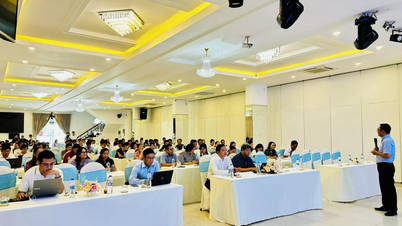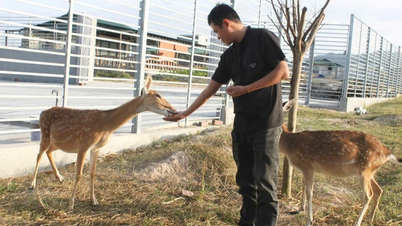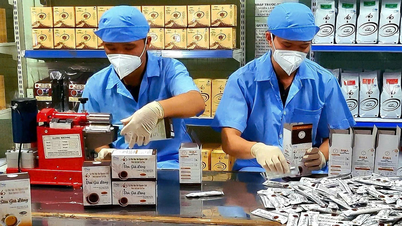Many families are subjective about their children's strabismus (also known as cross-eyed), thinking that it is just a small defect that will get better as they grow up. Unexpectedly, many children, after a long time of looking at vegetables and picking up meat, have developed amblyopia and are almost blind.
Signs of many dangerous diseases
Although he is not yet 5 years old, the left eye of patient NGL (in Bac Ninh ) can barely see anything. The patient's mother said that when he was 3 years old, he was diagnosed with a refractive error with a difference of more than 2 degrees between his two eyes. A few months ago, the family discovered that he often had signs of squinting, tilting his head when observing, often squinting, blinking, and looking in two different directions with his two eyes. When examined, the doctor discovered that in addition to strabismus, the patient also had amblyopia. The patient was prescribed amblyopia exercises to restore his vision, then surgery to correct the strabismus.
Meanwhile, patient LTM (19 years old, in Lai Chau ) was diagnosed with strabismus when he was a child, but it was not until adulthood, after struggling and working to make a living, that M. thought about strabismus surgery. M. shared that for many years he always felt inferior and was afraid to communicate because his friends made fun of him. "I used to ask my parents to let me go for treatment, but everyone said it would go away on its own when I grew up," M. said.
According to statistics, in our country there are about 2 - 3 million people with strabismus. It is worth mentioning that the phenomenon of strabismus in children is increasing and many families take their children to see a doctor and get treatment late, causing serious effects on vision. In fact, up to 70% of children with strabismus have refractive errors.
Dr. Le Thuy Quynh, High-Tech Eye Center - Dong Do Hospital, said that strabismus or squint is a common disease in children, but can also occur in adults. This is a condition in which the two eyes look but are not aligned, not looking in the same direction but in different directions. One eye can look straight ahead, while the other eye can look inward, outward, up or down. The disease has many causes, of which 30% are hereditary in the family.
"Parents should not be subjective when they see their children have squints because it can be a sign of a number of dangerous diseases, including congenital cataracts that cause the child's visual cells to degenerate and are very difficult to recover. In addition, refractive errors such as farsightedness, astigmatism or combined farsightedness and astigmatism also cause squints in children, especially when the refraction of the two eyes is different," said Dr. Quynh.

Associate Professor Ha Huy Tai examines a 19-year-old patient who is scheduled for strabismus surgery.
It's not just about beauty and ugliness.
Associate Professor, Dr. Ha Huy Tai - a leading expert on strabismus, former Head of the Department of Training and Scientific Research, Central Eye Hospital - said that strabismus is the leading cause of vision loss in children, and also affects life, activities and study if not treated properly. In children, about 3% have strabismus. Possible complications of strabismus are amblyopia, eye movement disorders...
According to Associate Professor Ha Huy Tai, there is a mistake that many people make, which is the view that "if a child has strabismus, it will go away on its own when he or she grows up." However, in reality, strabismus will cause the child's vision to be poorly developed. For young children, after determining the cause, assessing the eye function, measuring the degree of strabismus, and treating related diseases, if the strabismus does not improve, surgery will be indicated. Depending on the strabismus condition, the doctor will give the appropriate time for surgery, however, the best recommended age for surgery is before the age of 5.
"This not only solves the aesthetic function but also reduces the risk of affecting vision. Because for children with strabismus, up to 60%-70% will lead to amblyopia and vice versa" - Associate Professor Tai noted.
There are currently two main methods of treating strabismus: corrective lenses and surgery. Of these, surgical treatment of strabismus is applied when the above methods do not achieve the desired results or the cause of strabismus is due to muscle or nerve abnormalities.
Accordingly, the doctor will perform surgery to adjust the muscles attached to the eye. Strabismus surgery is usually performed as an outpatient procedure with a duration of less than 60 minutes. After surgery, the patient can be discharged immediately and return for a follow-up visit as directed by the doctor.
Up to 90% of strabismus cases will have a significant improvement in vision after surgery. However, there are cases that require 2-3 surgeries.
Pay attention to children's eyesight
Doctors say that eyes with refractive errors such as nearsightedness or farsightedness that are too severe for a long time can also cause strabismus. Children are at high risk of developing refractive errors, especially when they study in the wrong posture or use electronic devices incorrectly...
Doctor Le Thuy Quynh recommends that if parents see abnormalities in their child's eyes, such as squinting, they should take them to the doctor immediately, as this is a case of strabismus. In addition, if there is someone in the family with strabismus or reduced vision, the child should have an eye exam before the age of 3.
Source




































































































Comment (0)